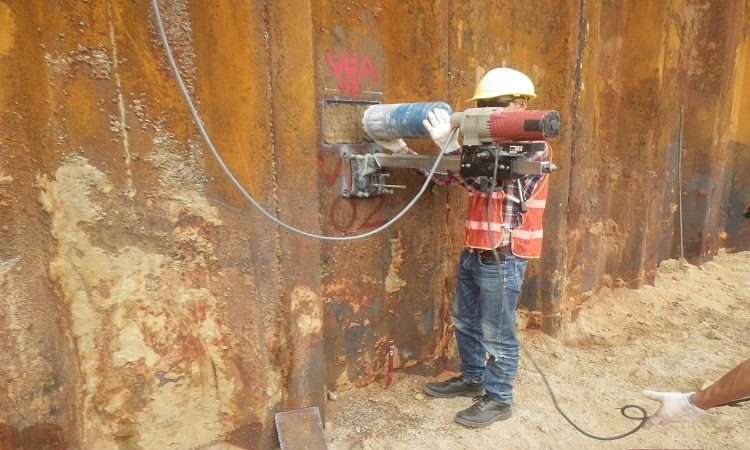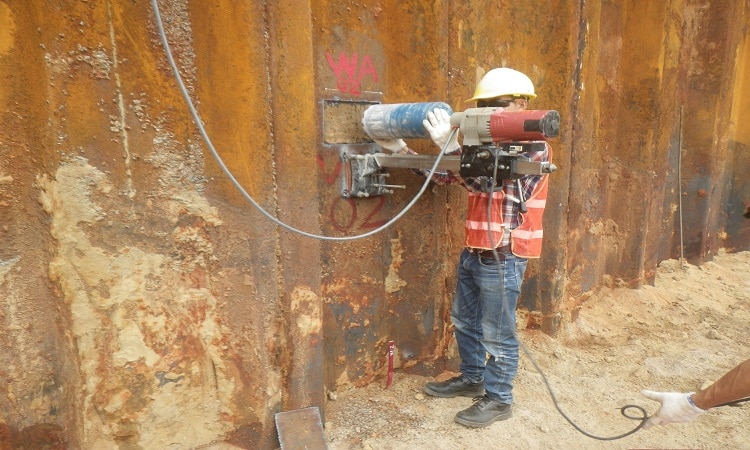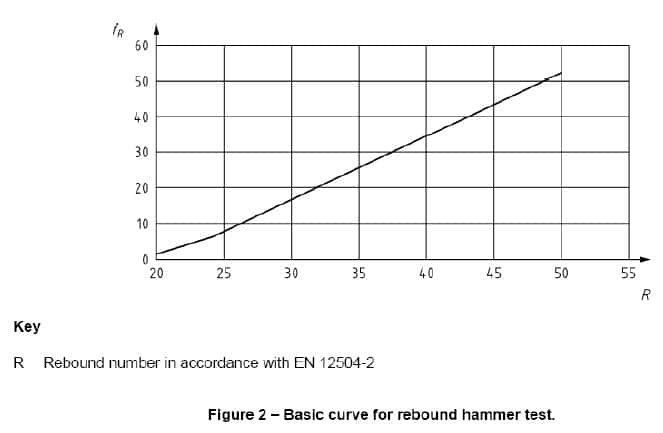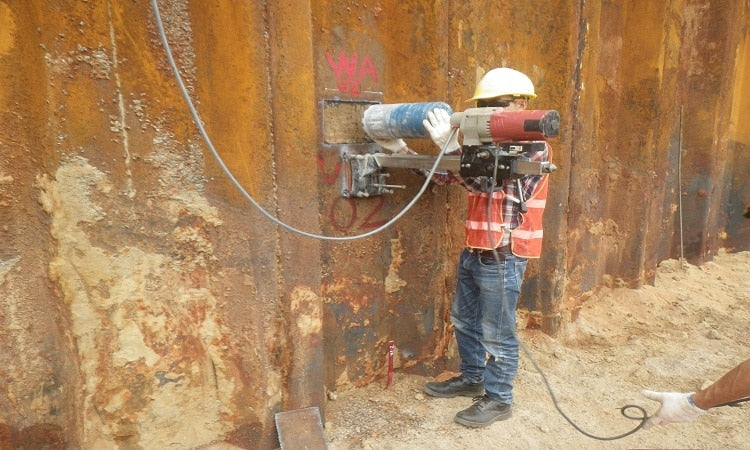The compressive strength of concrete and the yield strength of steel are two essential material strengths that must be tested during construction.
The yield strength of reinforcement is tested before its use in construction, in accordance with project specifications or building regulations. However, the compressive strength of the concrete was tested after concreting.
Samples taken during the Concrete will be tested. The test method and test criteria are described in the article Concrete Compressive Strength and Concrete Testing .
The usual tests of concrete cubes or cylinders are carried out to ensure, based on samples taken during concreting, that the concrete has developed the resistance intended for the structure.
On other occasions we test the concrete to check its resistance.
- If there are doubts about the conformity of the concrete tests, new tests are carried out to verify the resistance.
- When assessing the resilience of the existing structure for further use or conversions.
When carrying out structural assessments, the compressive strength of the concrete must be determined to verify the structural performance of the element. It is also important to know the compressive strength of concrete during renovation.
This article mainly deals with the assessment of the compressive strength of in-situ concrete. The in-situ compressive strength assessment guideline set out in EN 13791:2007 is discussed in detail.


First, let's explain some of the terms we use in this discussion.
- Compressive strength in place – Strength equivalent to a standard cube or cylinder
- Characteristic in-situ compressive strength – In-situ compressive strength values are below the expected 5% of all possible strength determinations of the volume of concrete in question – code definition.
- Characteristic strength of standard sample – The strength of the cube or cylinder is tested in the usual way. It is based on samples collected on site and cured before testing.
The ratio between the in situ characteristic strength and the characteristic strength of standard samples is 0.85.
The differences between cube strength and in situ concrete strength are due to the different environments available for strength development. The collected samples (molded concrete cubes or cylinders) are completely hardened in water by immersion until the test is completed. However, normal on-site concrete is not treated as intensively. Furthermore, the compaction of the concrete cube or cylinder may be greater than that of cast-in-place concrete.
It should also be noted that the ratio 0.85 or (1/0.85 = 1.18) is part of γC which is 1.5 according to BS and EN standards.
Let's see how we can evaluate compressive strength in situ.
Assessment of the compressive strength of in situ concrete
The following image shows the methods available to proceed with the project.


Now let's discuss each method in detail.
There are two methods available to assess the strength of concrete, depending on the availability of test results and the extent to which we can carry out the tests.
Strength classification by “ Core Test ” is the direct method in which we directly use the core strengths to evaluate the characteristic strength of the concrete in situ.
Assessment of characteristic strength of concrete in situ using the Indirect methods such as rebound hammer, ultrasonic speed and pullout test (non-destructive and semi-destructive) are called indirect method.
For larger areas that require many cores, an indirect method can be used, resulting in higher costs and reducing damage caused by core drilling.
Furthermore, it is important to note that depending on the area in which the structural assessment is carried out, we can only use the direct method (direct and simple) if applicable.
Testing cores (direct method)
There are two approaches, namely Approach A and Approach B.
Before we discuss the two approaches, let's look at the history of these tests.
- Core collection must be carried out in accordance with the applicable procedural rules. Dimensions and tolerances must be within specified limits.
- The number of cores to be taken for testing depends on the area/volume of concrete, purpose of testing, etc. However, at least one core must be removed from each test point.
- The in-situ compressive strength assessment for a specific test region must be at least three cores .
- This procedure applies to cores with a nominal diameter of at least 100 mm. The number of cores to be tested must be increased if the nominal diameter according to EN 13791 is less than 100 mm.
Let us now discuss the two approaches under the core testing method for evaluating the compressive strength of in situ concrete.
On-Site Stress Testing Through Core Tests: Approach A
- At least 15 cores must be available to proceed with this method.
- The in situ characteristic resistance is given by the following equations and the lowest value is obtained .
F ck, é =f m(n) é – k 2 xs
Or
F ck, is =f is, lower +4
Where
F ck, é – Characteristic compressive strength in place
Fm (n). – Average in-situ compressive strength of n results
F is, lowest – Lowest requirement for on-site compressive strength testing
s – standard deviation of test results or 2N/mm2, whichever is greater
k 2 – According to national regulations or assumed as 1.48 if no value is provided.
- If it turns out that the core strength values come from different types of concrete, the test area can be divided into two test areas.
In-situ resistance through main tests: Approach B
- This approach is implemented when the number of available core tests is 3 to 14.
- The in situ characteristic strength is considered the lowest of the following values.
F ck, é =f m(n) é – k
Or
F ck, is =f is, lower +4
The value of k can be found in the following table. Included N is the number of test results.
| N | K |
| 10 to 14 | 5 |
| 7 to 9 | 6 |
| 3 to 6 | 7 |
- This method generally produces lower estimated characteristic strengths than most other results.
- This procedure should not be used in cases of discrepancy regarding the quality of the concrete based on standard test data.
Through indirect methods
An indirect method is used in other tests such as rebound hammer, ultrasonic pulse velocity and pullout along with core tests after establishing a correlation between them.
Examination with Indirect methods measure properties other than strength . Therefore, it is necessary to establish a relationship between indirect test data and the compressive strength of the cores.
There are two alternatives.
- Alternative 01: Direct correlation with nuclei
If sufficient core test results are available (at least 18 core test results), a correlation can be made with the other tests (rebound hammer, etc.) as described in this article.
This means that the compressive strength of in situ concrete can also be achieved in other locations.
- Alternative 02: Base curve calibration based on limited test data and resistance determination
Those previously developed curve based is modified based on the results of the main and indirect tests. The compressive strength at the site is then determined from the modified curve according to the results of indirect tests at other sites.
Main characteristic of the indirect method
- This method can be considered an alternative to the basic test method discussed earlier. During core testing, structural elements are damaged and as a result the integrity of the structure may be lost.
- Using the indirect method is economical and less time consuming. Furthermore, the test is also easier compared to the main tests.
- Since we use a limited number of cores, the cost is also reduced.
- Indirect methods are used after calibration with cores.
Alternative 01: Direct correlation with main tests
- At least 18 pairs of results (18 primary test results and 18 indirect test results) are required to establish a relationship. Result pairs must be determined in the same location.
- Testing must be carried out at at least 15 different testing sites across the territory.
- The greater the number of tests, the more accurate the accuracy.
- The test data is used to evaluate the compressive strength of the concrete in situ.
- A compensation line or curve is used to determine resistance.
- The lowest value determined from the following equations is considered the in situ compressive strength.
F ck, is =f m(n). – 1.48h
Or
F ck, is =f is, lower +4
Where S is the standard deviation calculated from the test results or 3 N/mm. 2 whichever is greater.
Alternative 02: Use the relationship between cores and base curve
- At least 9 couples are required
- Can be used for normal concrete with the same set of materials and manufacturing process
- Changing the base curve given in EN 13791:2007 (E) for each indirect test method to establish the relationship with the main test results.
- The following approach is used to build the relationship.
- The selected range contains 9 pairs of test results.
- Each site has nine main results and one of nine indirect test method results.
- Calculate the difference between the main test result and the corresponding value on the base curve. δf =f Is -F R, V or F . (where R is the number of the rebound hammer, V is the speed of the ultrasonic pulse, and F is the pulling force)
- Calculate the amount to shift the base curve. Δf = δf m(n) – k 1 xs, where k 1 is taken from the table below and S is the standard deviation.
Number of paired test results, n Coefficient, k 1 9 1.67 10 1.62 11 1.58 12 1.55 13 1.52 14 1.50 ≥15 1.48 - The base curve started at a low position. Change is therefore always positive.
- Furthermore, we can use the following formulas to convert the indirect test value to the base curve values without having to do all the calculations mentioned above. Once we calculate the value, we can use the corresponding number to determine the compressive strength at the location.
Rebound hammer
F R = 1.25 x R-23; 20 ≤ R ≤ 24
F R = 1.73 x R-34.5; 24 ≤ R ≤ 50
Ultrasonic pulse speed
F against = 62.5 V 2 -497.5V+990; 4 ≤ V ≤ 4.8
pullout force
F F = 1.33(F -10); 10≤F≤60
The following figure (base curves) is intended to be used to develop the relationships of each indirect test method.
Basic Curve Recovery Hammer Test


Basic Curve Ultrasonic Pulse Speed Test


Basic curve pullout test


Worked example: Develop a relationship with Basic Curve – for Rebound Hammer
As discussed above, from the base curve we need to develop the relationship between the main result and the rebound hammer results.
The following figure illustrates the progression and connection.


The figure above only shows a representation with two points. However, as explained above, we need at least 9 result pairs. They must represent at least nine points.
The diagram above was taken from EN 13791:2007 (E), Figure 2 – Base curve for the rebound hammer test.
- After plotting all results (at least nine pairs of results in the same location), calculate a1, a2,… a9.
- Calculate the mean of a1, a2,…a9 and the sample standard deviation.
- Then calculate Δf = δf m(n) – k 1 xs, where k 1 is taken from the table above. (For nine results, k1 = 1.67 table and S is the standard deviation calculated above.
- Δf is now known, the displacement of the base curve. For evaluation, record the shifted curve.
- Obtain the relevant core strength (in situ strength) for other available rebound hammer test results.
These methods can be used to determine the compressive strength of concrete at the construction site. Furthermore, EN 13791:2007 provides guidance for assessing the strength of concrete when the conformity of the concrete is doubtful based on standard tests.
Additionally, you can find articles on different types of destructive testing and non-destructive testing to expand your knowledge.
Furthermore, concrete society guidelines could be tracked.
Restriction on the use of rebound hammers for these tests
- As we discussed, these tests measure properties, not strength. If surface hardness changes due to other environmental factors, the ability to obtain accurate test results will be reduced.
- Carbonation of concrete increases the surface stiffness and leads to increased hammer rebound number. So the actual condition may not be reflected.
- The rebound hammer test is more suitable for new concrete than for old concrete that has caused changes in the surface finish.
- Concrete surface moisture also influences the hammer rebound number.
- Degree of compression
Some important things from EN 13791 for designers
- There is a strong deviation between the test cube and the tested structure. This is mainly due to the healing process. We immerse the test cube in water until it is tested and harden the structure.
- A reduction in strength of 15% must be taken into account according to EN 13791.
- There is a higher material safety factor, e.g. For example, 1.5 used for concrete, whilst BS 8110 Part 1-1997 suggests 1.05 for steel reinforcement. The reduction discussed above could also have been considered for this.
- Although we consider characteristic strength during design, there is actually less strength available on site.

